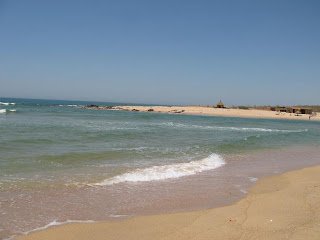
Captain Hamallah (left) and Chef/Guide Ayuba, with some freshly caught Niger fish, sitting at the rear of our pinasse.
The water looked cool and inviting. However, judging by the swollen bellies of the children living on the banks and the waste we saw going into the river from all manner of human and animal activity, it was anything but clean or fresh. Nonetheless, the river was calming and the Niger scenes captivating. On the banks we saw anything and everything being washed – babies, children, pots & pans, clothes, goats, furniture and even a Mercedes. We observed, smiled and waved and almost all the locals took a moment from their fishing and bathing to smile and wave back. 
Friendly waves from two children. Note the tiny feet of a young sibling being carried on the girl's back.
The traffic on the river consisted mostly of small black pirogues – canoes propelled by pushing against the river bed with long bamboo poles. Some had makeshift sails; many had cargo as diverse as produce for market, motorbikes, fridge freezers and, of course, people. Some were laden to what looked like sinking point, just like every other mode of transport in West Africa.
A typical Niger pirogue.

These two sailors give their bamboo poles (and arms) a rest, letting the sail do the work.

Passengers rest on solid ground by their pinasse. Surely there is a kitchen sink packed somewhere on this vessel.
Every so often we stopped to visit a Niger village, and our presence proved to be quite the novelty for the local children who invariably followed us everywhere, shouting “Toubab!!”. We bought fresh (still alive) catfish in Barundaga from Bozo people, visited the Songhaї people and their salad farm in Nantaka, admired the mud mosque in Sekoubangou and accepted an invitation to dance with the Fula people in Gumina, much to the amusement of the villagers watching the spectacle.

We enjoyed a delicious catfish lunch, thanks to this family in Barundaga who caught and sold us the fish.

We had a great time with the children we met along the Niger, but left without attempting to take any of them with us. We'll leave that to Madonna & Guy and Brad & Angelina.....
 These two young Fula women gave us a great welcome in Gumina. The black circles around their mouths are decorative tattoos, typical amongst Fula women.
These two young Fula women gave us a great welcome in Gumina. The black circles around their mouths are decorative tattoos, typical amongst Fula women.

Having fun and shakin' some booty with the women of Gumina.

This boy proudly poses on his shiny bike.
By the time we set up camp for the night we’d been welcomed in five villages, learned and practised greetings in three new local languages and had our arms grabbed by several hundred children. We camped on a quiet bank near Kotaka, the peace only disturbed by big pinasses travelling by night with radios cranked.

Lunch, anyone?
The next day we continued along the Niger to Koubi, a Fula village where we watched an elder weaving wool cloth and spent a good hour trying to find a chicken for lunch. Ayuba, our chef and guide, finally found a bird for the “good price” of 1,200 CFA (about $2.50), and by the time we pulled away from the waving village children, our feathered friend was killed, plucked and ready for the pot.

Enjoying the breezy shade of our pinasse.
It was refreshing to forget buses, trains and bush taxis for a couple of days and savour the peaceful topaz waters of the Niger without the distractions of honking, swerving, dust and other passengers. Next time we’ll make it a three day trip and sail all the way to Timbuktu.
Merci et au revoir!
Next on Donkey Crossing: stories & pictures from Mali’s magical Dogon Country. Check back soon!




 Here I am lining one up on the final hole.
Here I am lining one up on the final hole.
























 The family congregate for a photo by the heart of the home: the shady mango tree.
The family congregate for a photo by the heart of the home: the shady mango tree. This is a tight knit community, and we observed a particularly strong bond between the women.
This is a tight knit community, and we observed a particularly strong bond between the women. On our last night in Dakar, we played host for a change and took Abdou to a fabulous Cape Verdean restaurant. This was a small token of our appreciation for his generous hospitality.
On our last night in Dakar, we played host for a change and took Abdou to a fabulous Cape Verdean restaurant. This was a small token of our appreciation for his generous hospitality.








